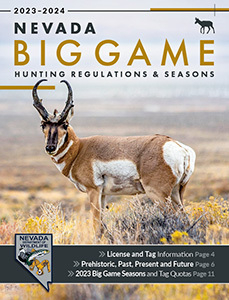Mountain Lion Hunts
(NAC 502.370)
Resident and Nonresident (CR 23-06) Mountain Lion Hunts - Either Sex |
|
Any Legal Weapon |
|
Unit Group |
Harvest Limit |
Statewide except units 033, 269, 280, 281, 282, 283, 284, 286. |
247 |
Harvest
Mountain lion harvest limits are established annually. When the harvest limit has been met for a given region, the season is closed. Prior to hunting, tagholders must call the Mountain Lion Harvest Information Hotline at any time to determine if the season has been closed due to the harvest objective being reached. The hotline number is 1-800-800-1667, and is accessible 24 hours a day. Mountain lion tags are available for residents and nonresidents to purchase over the counter (two per year) at NDOW offices, license agents and online at
Limit
1 animal per tag, 2 tag maximum per person. (Refer to NAC 502.370)
Sex
Either sex, Spotted kittens and females with spotted kittens prohibited. See NAC 502.370
Hours
Any time of the day or night — Please check with your local law enforcement office for county ordinances regarding night time shooting. Hunters are responsible for checking local regulations.
Special Regulations
A hunter, or their licensed guide if applicable, must call the mountain lion hotline at 1-800-800-1667 prior to hunting to determine if a unit group is open or closed.
*Interstate hunt with Utah. Nevada and Utah hunters may hunt within open units in both states. (Nevada Unit 091, Utah Unit 1c.) Nevada hunters hunting in Utah must abide by Utah regulations and season dates on the Utah portion of the hunt area.
Hunting with a Dog
It is unlawful to hunt, chase or pursue:
- Any fur-bearing mammal with a dog except during the open season and under the authority of a valid hunting or trapping license. (Refer to CGR 496, R-009-21).
- Any fur-bearing mammal with a dog except during the open season and under the authority of a trapping license.
(Refer to NAC 503.147)
Hunting Mountain Lion with a Handgun or Shotgun
A person may hunt big game mammals with a handgun if the handgun uses a centerfire cartridge of caliber .22 or larger and has a barrel length of 4 inches or more (see note below).
A person may hunt deer and mountain lion with a shotgun no larger than 10 gauge and no smaller than 20 gauge. Only rifled slugs or shotgun rounds with sabots that contain a single expanding projectile may be used when hunting deer. A shotgun that is used to hunt deer or mountain lion pursuant to this subsection may be equipped with a smoothbore barrel or a barrel that is partially or fully rifled.
(Refer to NAC 503.142)
Note: Legal Weapons — Only legal weapons authorized for big game (Weapons Regulations). Rimfire .22 or other rimfire cartridges are not legal weapons for hunting mountain lions.
Guiding for Mountain Lion
A master guide who is hired to guide a hunt for a mountain lion shall ensure that the client physically accompanies him or his subguide in the pursuit and killing of the mountain lion.
(Refer to NAC 504.701)
Use of Flashlight in Mountain Lion Hunt
A person who is hunting, chasing, or pursuing a mountain lion, pursuant to a mountain lion tag, and who is not in or on a motorized vehicle, may use a flashlight which is hand-held and powered by a dry cell.
(Refer to NAC 503.189)
Mountain Lion Tags: Eligibility; Expiration; Duties Upon Harvesting; Restrictions; Report of Accidental Trapping or Killing.
A tag is required to hunt mountain lions, which can be purchased from the Department or license agent. A resident or nonresident can obtain up to two (2) tags a year. The tag can be used in any open management unit or group of units during an open season and expires upon termination of the season.
Mountain lion season begins March 1 and ends either on the last day of the next February or when the number of harvested mountain lions reaches the quota limit, whichever happens first.
A person who harvests a mountain lion shall, within five days after harvesting it, personally present the unfrozen skull with the jaws propped open and the unfrozen pelt in its entirety to a representative of the Department for inspection, along with any records regarding the mountain lion. These records must include sex of the mountain lion, removal of the premolar tooth, and a tissue sample. You will also need to include the location where the mountain lion was killed, including the unit or units of the management area and the coordinates of the location as identified by latitude and longitude using decimal degrees or by using the coordinates of the Universal Transverse Mercator System.
If a mountain lion is accidentally trapped or killed, the person trapping or killing it shall report it within 48 hours to a representative of the Department.
Please Note: You cannot kill a mountain lion accompanied by a kitten or kill a spotted kitten. (Refer to NAC 502.370)
Attention: Mountain Lion Hunters
The Nevada Department of Wildlife is requesting that hunters allow for the removal and retention of one premolar tooth from each harvested mountain lion when presenting the skull and hide to NDOW for sealing. Please present the skull, unfrozen, or with the mouth fixed open. The premolar tooth will be used to accurately age harvested mountain lions. NDOW is also asking that a one-inch-square piece of tongue, or other muscle tissue from each lion to be turned in at the same time for future DNA testing.
Teeth and skulls can be presented at any NDOW regional office. Please call first to confirm biologist availability.


